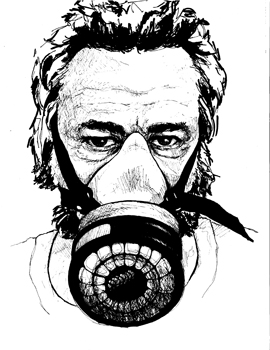Tell us about the beginnings of this story. How did the story take shape as you were writing? How did you understand it was time to close?
It started with just the image of the boy standing in a bedroom wearing nothing but a track jacket. I wasn’t even sure I would get to use that in the story, but the whole tone and mood came out of that. The boy was a nightmare to work with—withdrawn, hard to bring out on the page—until I stumbled on the solution of the track jacket implying a minor but cherished track history. If you’ve got an image, you might as well find a practical link between it and the story. The opening and closing line was something I’d wanted to use for ages, and it fit well here. Using it for both reminded me of a record spinning and of “Goodbye Sky Harbor,” the recursive last song on Clarity, so I took a chance with closing out that way. Aside from that one sentence, though, that jacket pretty much wrote this whole piece.
There is such a specific intimacy between the boy and the girl—it’s sharp, calm. What do you think moments like these do for the world?
I’d love to be able to say that those moments create greater understanding and tenderness between people. And often they do. They can turn into disasters, though. Intimacy needs time to process its meaning. It needs a strange combination of effort and fearlessness and intuition. Plenty of people are just as likely to wither in embarrassment or lash out in shame when someone reaches them at their most vulnerable. Some people just need a slower approach.
Something I wonder is how different this scene would’ve been had it taken place in her room rather than his, how much that would’ve changed the way they react to one another. So much understanding is based on context. For what it’s worth, I think hookups should happen in strangers’ bedrooms or awkwardly public locations. Then after you’re done you take off and nuke the site from orbit. It’s the only way to be sure.
“The boy had never seen these doodles, but would have declared them art.”
The way the boy believes in the girl is remarkable. Tell us more about the way the girl believes in the boy.
The particular faith they have in each other at the opening is born out of very specific pop cultural ideas of one another. I don’t think they’re seeing each other clearly yet. They’re seeing the types the other is portraying at this point in life. The girl believes in the affected seriousness he projects, which lets her be as cavalier as she is. I think she understands him better by the end once she’s seen the actual, openhanded vulnerability behind that impossibly emo identity. She won’t be composing sonnets anytime soon, but she believes in his feelings. That’s something.
We’re curious about the POV shift here. Can you tell us more about it?
The POV shift is partly because I’ve been working on a novel the past year or so. It’s become natural for me. But I’m also finding it more comfortable than just staying in one character’s perspective, even during a brief story. I always feel like one perspective doesn’t give enough of the story unless you’re really good at distinguishing what the character believes is true from what’s really true. Junichiro Tanizaki’s phenomenal at that. I am not yet Junichiro Tanizaki. Aside from that, using one character’s perspective to slide into another and hopefully gain some understanding of both is a technique that, when done cleverly enough, can be an elegant, empathetic way of expressing the conflicts between them. It’s a technique I really want to develop further as I go on.
How has Amy Hempel’s influence shaped this story?
I was lucky enough to have Amy as a teacher at both my undergraduate and graduate schools, so her influence on my writing is considerable. I learned a lot from her about development of tone, and the way countering tones with each other can amplify both. Looking at it that way, this story feels like the literal version: Funny and Sad spend the night together, and become more intensely themselves because of it. Amy loves to discuss the use of humor in complicating stories, and that’s had a big effect on how I examine the tone of my own work.
If you could tell the girl one thing, what would it be?
I was at a Halloween party a few years ago, when a girl nearby yelled out, “For the last time, I’m not Hitler, I’m Charlie Chaplin!” And it was a hell of a Chaplin costume, but Hitler’s the risk a Chaplin costume entails. The point is, you can’t help what people are going to see in you. But you can be ready for it. Earnest indie boys are going to see their misguided dreams reflected in you for a long time coming, and you’re going to have to do your best to be kind about it, even in those moments when you come to hate your own kindness. You will, because sometimes selfishness is a valid defense. But try to be kind.
The boy?
A few weeks ago, I was lucky enough to see a 35mm print of the original Friday the 13th, and I was reminded again how lovely a movie it is: patient, quiet, and lush. It’s a remarkably thoughtful story about loss and gets there with decapitations rather than navel-gazing. How many people would stand by me on this? Almost no one. How many people need to? Absolutely no one. Take stock of the things that move you, and focus on the ones that surprise you. Throw away anything that allows you to pander to yourself. Anyone can take a sad photo of an abandoned building, and anyone can look at it and pretend it’s deep. Find the weirdest things that move you. Find your Friday the 13th.



 The core workshop of SmokeLong Fitness is all in writing, so you can take part from anywhere at anytime. We are excited about creating a supportive, consistent and structured environment for flash writers to work on their craft in a community. We are thrilled and proud to say that our workshop participants have won, placed, or been listed in every major flash competition. Community works.
The core workshop of SmokeLong Fitness is all in writing, so you can take part from anywhere at anytime. We are excited about creating a supportive, consistent and structured environment for flash writers to work on their craft in a community. We are thrilled and proud to say that our workshop participants have won, placed, or been listed in every major flash competition. Community works.